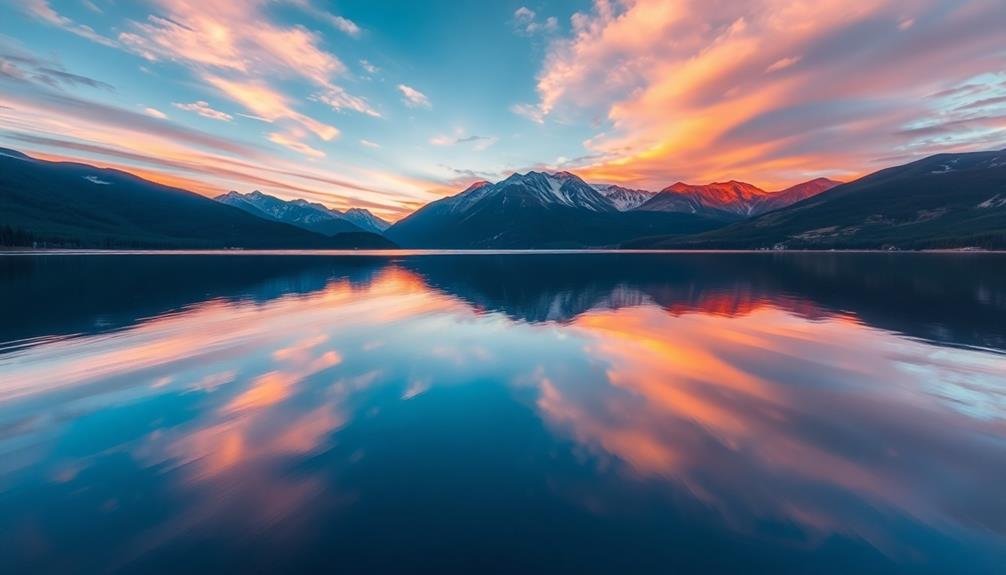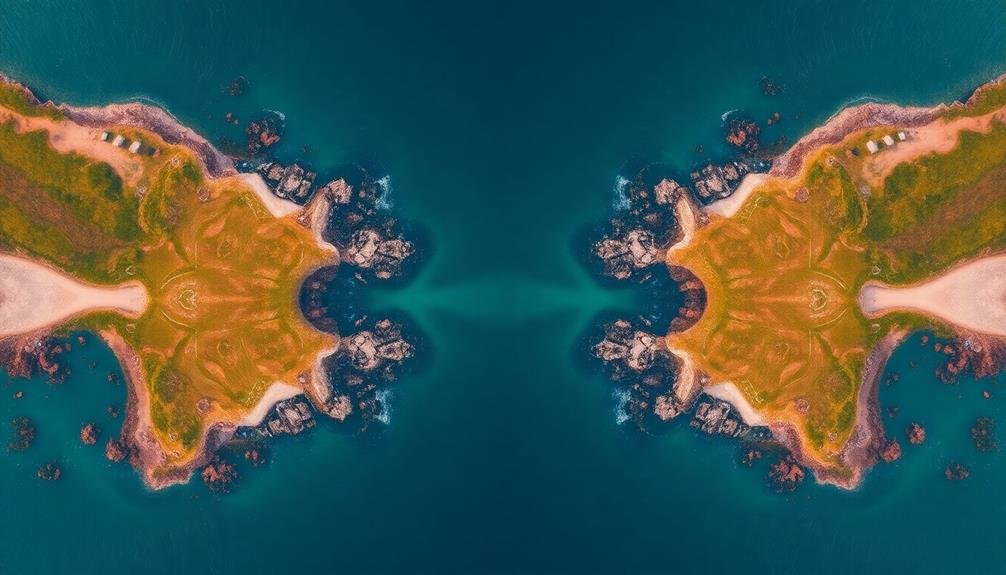To capture stunning symmetry in aerial photography, you'll need to master composition and framing techniques. Look for natural patterns, leading lines, and reflections to create balanced images. Use rivers, coastlines, and urban grids as symmetrical elements. Apply the rule of thirds and experiment with different angles and altitudes. Enhance depth perception with diagonal lines and S-curves. Shoot during golden hour for dramatic lighting and reflections. In post-processing, straighten horizons, crop strategically, and fine-tune contrast and clarity. By understanding these principles, you'll elevate your aerial shots from ordinary to extraordinary. The sky's the limit for your symmetrical masterpieces.
Key Takeaways
- Align the camera directly above subjects for perfect symmetry, using leading lines as a framework for symmetrical arrangements.
- Utilize natural mirrors like water bodies to create stunning reflections, especially during calm days and golden hour lighting.
- Exploit geometric patterns in urban landscapes, such as city grids and housing developments, for symmetrical compositions.
- Apply the rule of thirds when placing key elements, and explore various angles and altitudes for visually appealing balance.
- Use post-processing techniques to fine-tune symmetry, including straightening horizons, aligning edges, and creating flawless mirror effects.
Finding Natural Symmetry From Above

When you're searching for natural symmetry from above, start by looking for landscapes with repeated patterns or mirrored elements. Rivers and coastlines often create stunning symmetrical shapes, especially where they meet land or other bodies of water. Look for meandering rivers that form S-curves or oxbow lakes, which can create near-perfect symmetry.
Forests and agricultural fields are excellent sources of natural symmetry. Tree canopies can form intricate patterns, while crop fields often display geometric shapes and lines. Mountain ranges and canyons can also offer symmetrical formations, particularly when viewed from directly above.
Pay attention to shadows, as they can enhance symmetry or create their own patterns. Early morning or late afternoon light works best for this effect.
Water reflections are another powerful tool for creating symmetry in your aerial shots. Calm lakes or flooded areas can double the symmetry of surrounding landscapes.
Don't forget to scan for human-made elements that complement natural symmetry. Roads, bridges, or even boats can add interesting touches to an otherwise purely natural scene.
Experiment with different altitudes to find the perfect balance of scale and detail in your symmetrical compositions.
Framing Techniques for Balanced Compositions

To nail balanced compositions in aerial photography, you'll need to master key framing techniques. Start by using the rule of thirds to divide your frame into a 3×3 grid, placing key elements along these lines or at their intersections. This creates a more dynamic and visually appealing image than centering your subject.
Utilize leading lines to guide the viewer's eye through the composition. Look for natural or man-made lines like roads, rivers, or building edges that draw attention to your focal point. Experiment with different angles to find the most compelling perspective.
Pay attention to symmetry and balance within your frame. You can achieve this by positioning elements on opposite sides of the image or by using reflections in water bodies.
Don't be afraid to crop in-camera to remove distracting elements and strengthen your composition.
Consider the negative space around your subject. This empty area can create a sense of scale and emphasize your main subject.
Use contrasting colors or textures to further enhance visual interest and balance in your aerial shots.
Using Leading Lines for Symmetry

When capturing symmetrical aerial shots, you'll want to identify natural leading lines that guide the viewer's eye through the image.
These lines, such as roads, rivers, or architectural features, can help you create balanced compositions by dividing the frame into equal parts.
Identifying Natural Leading Lines
In spite of their natural occurrence, leading lines can be powerful tools for creating symmetry in aerial photography. When you're scanning the landscape from above, keep an eye out for rivers, roads, shorelines, and mountain ranges. These features often form natural leading lines that can guide the viewer's eye through your composition.
Rivers and streams are particularly effective, as they often meander in serpentine patterns that create a sense of flow and balance. Look for bodies of water that divide the frame evenly or form interesting shapes.
Roads and highways can also serve as strong leading lines, especially when they cut through contrasting landscapes or form geometric patterns.
Shorelines offer a natural boundary between land and water, creating a clear line of symmetry. Mountain ranges and ridgelines can provide dramatic diagonal lines that add depth and dimension to your aerial shots.
Don't forget to contemplate tree lines, field boundaries, and even shadows cast by tall structures. These subtle lines can add layers of symmetry to your composition.
When identifying natural leading lines, try to envision how they'll appear from different altitudes and angles. Experiment with your drone's position to maximize the impact of these lines on your overall composition.
Creating Balanced Compositions
Once you've identified natural leading lines in your aerial view, it's time to harness their power for creating balanced compositions. Use these lines as a framework to guide your symmetrical arrangement. Position your camera so that the leading lines converge towards the center of the frame, creating a natural focal point. This technique draws the viewer's eye into the image and establishes a sense of order.
To achieve perfect symmetry, align your camera directly above the subject. Verify that the horizon line is perfectly level and centered in the frame. Look for reflections in water bodies or mirrored architectural features to enhance the symmetrical effect.
Don't forget to take into account the rule of thirds when placing key elements within your composition. Experiment with different angles and altitudes to find the most visually appealing balance. Sometimes, slight asymmetry can add interest to your photo while maintaining overall equilibrium.
Use post-processing tools to fine-tune your composition, adjusting crop and perspective if needed. Remember, balanced compositions don't always mean perfect symmetry; they're about creating a harmonious distribution of visual weight across the frame.
Enhancing Depth Perception
Leading lines play an essential role in enhancing depth perception in symmetrical aerial photography. They guide the viewer's eye through the image, creating a sense of distance and dimension. When you're capturing symmetrical scenes from above, look for natural or man-made lines that converge towards a central point. Roads, rivers, and architectural features can serve as powerful leading lines.
To maximize the impact of leading lines in your symmetrical aerial shots:
| Technique | Effect |
|---|---|
| Diagonal lines | Create dynamic tension |
| Curved lines | Add grace and flow |
| Parallel lines | Enhance symmetry |
| Converging lines | Emphasize perspective |
| S-curves | Guide eye through frame |
Use these lines to draw attention to your main subject or to create a balanced composition. You'll find that incorporating leading lines can transform a flat, two-dimensional image into a fascinating three-dimensional scene. Remember to experiment with different angles and heights to find the most effective leading lines. By mastering this technique, you'll add depth and visual interest to your symmetrical aerial photographs, making them more engaging and memorable for viewers.
Creating Reflections in Aerial Photography

Through the lens of aerial photography, reflections offer a fascinating way to create symmetry in your shots. Water bodies are your best allies in this endeavor, serving as natural mirrors that can double the visual impact of your composition.
To capture stunning reflections, you'll need to fly on a calm day when the water's surface is still. Position your drone to frame both the subject and its reflection, ensuring the horizon line splits the image evenly.
Consider these techniques to enhance your reflective aerial shots:
- Use polarizing filters to control glare and increase the visibility of reflections
- Experiment with different altitudes to find the perfect balance between subject and reflection
- Try shooting during golden hour for warm, dramatic lighting that accentuates reflections
Don't limit yourself to just water reflections. Glass buildings, wet roads, and even puddles can create interesting symmetrical effects.
Remember to adjust your camera settings to account for the reduced light in reflective scenes. A slower shutter speed can help capture more detail in the reflection, but be mindful of potential motion blur.
With practice, you'll master the art of creating enthralling symmetrical compositions using reflections in your aerial photography.
Symmetrical Patterns in Urban Landscapes

Urban landscapes offer a treasure trove of symmetrical patterns for aerial photographers. You'll find geometric shapes, repeating structures, and organized layouts that create visually striking compositions from above. Look for city grids, housing developments, and industrial complexes to capture perfect symmetry.
To make the most of urban symmetry:
- Fly at different altitudes to find the ideal perspective
- Use a gimbal to keep your camera steady
- Experiment with various angles to highlight symmetrical elements
- Consider shooting during golden hour for enhanced contrast
Here's a guide to common symmetrical patterns in urban landscapes:
| Pattern Type | Description | Best Time to Shoot |
|---|---|---|
| Grid Streets | Perpendicular intersections | Midday for minimal shadows |
| Radial Roads | Streets radiating from a central point | Early morning or late afternoon |
| Circular Parks | Round green spaces within urban areas | Sunrise or sunset |
| Identical Houses | Rows of similar residential structures | Overcast days for even lighting |
| Parking Lots | Organized arrangement of vehicles | Weekdays during business hours |
Post-Processing for Enhanced Symmetry

After capturing your aerial shots, you'll often find opportunities to enhance symmetry during post-processing.
You can start by aligning horizons and edges to create a more balanced composition, then crop your image to achieve perfect symmetry.
Don't forget to digitally enhance reflections, which can dramatically improve the overall symmetrical effect in your aerial photographs.
Aligning Horizons and Edges
Post-processing offers two key tools for enhancing symmetry in aerial photographs: horizon alignment and edge straightening. These techniques can transform a slightly off-kilter image into a perfectly balanced composition.
To align your horizon, use your editing software's straighten tool. Drag a line along the horizon in your image, and the software will rotate the photo to make it level. This simple adjustment can dramatically improve the overall symmetry and visual appeal of your aerial shot.
For edge straightening, focus on prominent vertical or horizontal lines in your image. Use the transform or perspective correction tools to adjust these edges, ensuring they're perfectly straight and parallel to the frame's edges.
When aligning horizons and edges, keep these tips in mind:
- Maintain natural proportions to avoid distorting the image
- Pay attention to reflections in water bodies for perfect symmetry
- Use grid overlays to guide your adjustments
Cropping for Perfect Balance
Cropping is a powerful tool for enhancing symmetry in aerial photography. You'll often find that even well-composed shots can benefit from strategic cropping to achieve perfect balance.
Start by identifying the central point or line of symmetry in your image. This could be a road, river, or architectural feature.
Use your editing software's crop tool to adjust the frame, ensuring equal space on both sides of your symmetry line. Pay close attention to the edges, making sure they're parallel to your subject's lines when appropriate.
Don't be afraid to crop tightly; sometimes, less is more when it comes to symmetrical compositions.
For circular or radial symmetry, use a square crop to emphasize the balanced nature of your subject.
When dealing with reflections, experiment with different crop ratios to find the most pleasing balance between the real object and its mirror image.
Enhancing Reflections Digitally
In addition to cropping, digital enhancement techniques can take your symmetrical aerial shots to the next level. Post-processing tools offer powerful ways to amplify reflections and create stunning mirror-like effects.
Start by adjusting the contrast and clarity of your image, focusing on the reflective surface to bring out details.
Next, use selective editing to enhance the reflective area. You can:
- Increase the saturation and vibrancy of the reflection
- Apply a subtle blur to smooth out any imperfections
- Adjust the luminosity to make the reflection pop
Don't forget to maintain a natural look by matching the enhanced reflection to the original subject. Use masks and gradients to blend your edits seamlessly with the rest of the image.
For perfect symmetry, try duplicating and flipping the top half of your image. Blend it with the bottom half using layer masks to create a flawless mirror effect. This technique works especially well for water reflections.
Frequently Asked Questions
How Does Weather Affect Symmetry in Aerial Photography?
Weather considerably impacts aerial symmetry. You'll find clear skies enhance reflections in water bodies. Wind can disrupt patterns in fields or forests. Clouds create interesting shadows. Fog or haze can soften edges, affecting overall balance in your shots.
What Drone Features Are Essential for Capturing Symmetrical Aerial Shots?
You'll need a drone with GPS stability, altitude hold, and a high-quality camera. Look for features like gimbal stabilization, adjustable aperture, and RAW image capture. Don't forget obstacle avoidance and long battery life for better shots.
Are There Legal Restrictions for Taking Symmetrical Aerial Photographs in Certain Areas?
You'll face legal restrictions when taking aerial photos in many areas. Check local laws, as some places prohibit drone flights near airports, government buildings, and private property. Always obtain necessary permits before flying to avoid fines or legal issues.
How Can Photographers Maintain Image Quality When Zooming for Symmetrical Compositions?
To maintain image quality when zooming for symmetrical compositions, you'll want to use a high-resolution camera, shoot in RAW format, keep your ISO low, and employ a sturdy tripod or gimbal to minimize camera shake.
What Are the Best Times of Day for Capturing Symmetrical Aerial Shots?
You'll get the best symmetrical aerial shots during golden hour, just after sunrise or before sunset. The low, warm light enhances contrast and creates long shadows, adding depth to your compositions. Don't forget blue hour for stunning twilight symmetry.
In Summary
You've now unfastened the secrets of symmetry in aerial photography. Remember, it's all about perspective and balance. Keep an eye out for natural symmetry, use framing techniques, and leverage leading lines. Don't forget to play with reflections and urban patterns. Finally, fine-tune your images in post-processing to perfect that symmetrical look. With these tools, you'll create stunning aerial shots that captivate viewers and showcase the world's hidden symmetry from above.

As educators and advocates for responsible drone use, we’re committed to sharing our knowledge and expertise with aspiring aerial photographers.




Leave a Reply